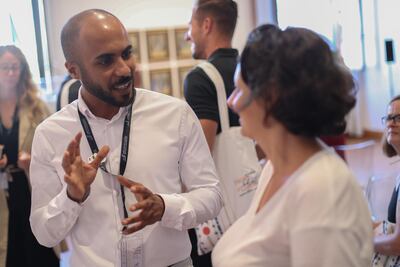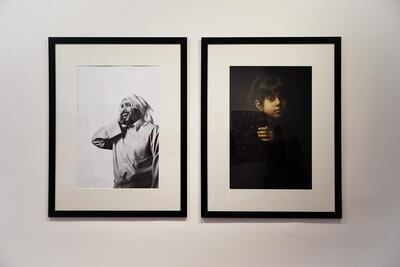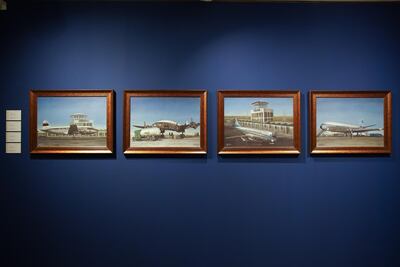Along Venice's Grand Canal, red carpet and white tables have been set up outside the Scoletta dell'Arte dei Tiraoro e Battioro. Stanchion posts with black ropes line the entrance to the building. Arabic music sails from the inside out to the street. In this little pocket of Venice, Kuwait has arrived. The cause for all this is to mark the opening of the exhibition In My Dream I Was in Kuwait, which features works by Kuwaiti artists Ahmed Muqeem, Nasser Behbehani and Khaled Alnajdi.
Working across drawing, painting and photography, the artists in the show offer their subjective truths about Kuwait, not so much as a form of representation, but as a way to reveal their own relationships to their history and culture. Running until Friday, November 1, In My Dream I Was in Kuwait is the second in a two-part show organised by the fine arts centre of Kuwait's Sheikh Abdullah Al Salem Cultural Centre (ASCC). The first iteration from June to this month featured artists Zahra Marwan, Mahmoud Shaker and Amani Al Thuwaini. All six artists have been part of the centre's inaugural Artist in Residence programme, which began in September last year.

"The exhibition does not seek to provide a portrait of the Kuwaiti art scene that has often served to satisfy a curiosity inclined towards the 'exotic'," say curators Francesca Giubilei and Luca Berta of Venice Art Factory in their curatorial statement. "Instead, it presents the plurality of the artistic practices from these six artists."
In other words, In My Dream I Was in Kuwait is not an all-encompassing show of "what's next" in contemporary Kuwaiti art. Rather, it shares narratives from the country as told through each artist's preoccupations. For example, Muqeem's works – portraits of Kuwait's past leaders rendered in charcoal on paper, as well as a series of paintings chronicling the development of the country's international airport – reveal the artist's patriotic sentiments, blurring the lines between historical documentation and personal memory.
Muqeem cites the influence of Renaissance paintings, specifically the commissioned portraits of powerful figures at the time. "I saw the portraits of the leaders and important people who made a big impact in this country [Italy]," he says. "So, as a Kuwaiti artist, I wanted to do this for my leaders."
Meanwhile, Alnajdi's paintings give us a glimpse into his psyche, but also his perception of Kuwaiti society. On the surface, Women at the Balcony seems to be a nostalgic take on Kuwaiti society from the 1960s, depicting a row of vibrantly painted women chatting away. "They're gossiping, having fun, laughing, but if you see them, they don't have expensive watches or things," he says. "They don't have mobiles. They gather and they socialise, and you can see they are happy."
Beneath this layer of idealism is a critique of today's social interactions. This can be seen in the rest of his canvasses, which show a crowd of blurry faces, indistinct and fragmented, as in Social Anxiety. There's also Obey and Survive, contrasting rows of people dressed in white against a row of individuals in different coloured clothes. The groups face opposite directions, and the colourful dressers have their faces scraped and erased.
"In our society and everywhere in the world, people who obey, live, and people who do otherwise, don't," Alnajdi says. "But people who are against the rules are scientists, artists or brilliant people. They're suffering to live, but they are very colourful. They chose themselves."

In his photographs, Behbehani opts for plain backgrounds, stripping the visuals of context to bring focus to the subject. In the show, two sets of portraits have been placed next to each other as a way to bridge past and present, tradition and progress. For example, a staged portrait of a naham, or the singer on a pearling boat, is placed next to an image of Behbehani's young daughter looking right into the lens. The decision to develop this dialogue was led mostly by the curators, allowing the works to have more nuance and depth.
"I was concentrating on only the past of Kuwait, but then the curators saw these connections between the past and the present, and I liked it a lot," he says, acknowledging that this helped him see his work in a new light. It is a small testament to the importance of exhibition-making and for an artist to see how his work can be shown and perceived by visitors.

"It's a great idea to merge different cultures," says Mauro Genovese, a visitor to the exhibition, who had never seen work by Kuwaiti artists before. "I found it interesting to see contemporary artists who are not from a particular school [of art], but bringing their own different styles."
Marwan, whose pen and watercolour works were shown during the first exhibition in June, says she hopes the exhibitions reveal the intricacies of Kuwaiti identity and society. "I hope that people who have never seen Kuwaiti art before or know much about the culture realise that there are many stories, imagery and a wide range of identities from such a small population," she says.
Growing up in New Mexico and Kuwait City, Marwan incorporates influences from these "two deserts", as she refers to her illustrations, to create sketches that reflect both her personal experience and cultural elements. "Often abroad, I'm associated with wealth, war, infringement on migrant workers' rights and women's oppression, but it's so much more complex," she says.
These exhibitions, however, are only one part of ASCC's programme, which also includes workshops and visits to the studios of contemporary artists. The Kuwaiti artists will also explore the many exhibitions forming the 58th Venice Biennale, which runs until November.
While in Italy, the artists will also engage with Venetian artisans such as glassblowers and mosaic masters. Venetian glass has a storied past that dates back to the 13th century, with the island of Murano becoming the epicentre of glassmaking in Europe.
The artists will visit renowned Murano glassmakers Salviati, which has been around since 1859. Inside their factory, about five artisans busily perform their specific tasks. As they move from placing the glass in the furnace to shaping it with their breath and cooling it in a temperature-controlled kiln known as a lehr, a kind of choreography emerges.
The Kuwaiti artists will then collaborate with these artisans, creating sketches that interpret their artworks into glass. This exercise in abstraction and material is something Alnajdi hopes to draw inspiration from. "I'm excited to know what they're doing, so I can incorporate this into my work." Pointing to his paintings, he says, "I'm excited to see how this comes to life in a glass bowl or something."
Marwan, who worked with Simone Cenedese, another Murano glass factory, in June, explains how she translated her illustrations into glass. "I started writing out words for contrast as opposed to imagery, like 'angular', 'fluidity', 'awkward' and 'relatable.' From there, I sketched a rainbow of sorts, to play more with the colours."
Although her piece broke during the process, Marwan says she makes it part of her artistic approach to adapt. "I'm in a constant practice of using my creative facilities to do what I can with what I have."

The second batch of artists will also pay a visit to Venice's Artefact Mosaic Studio, run by Alessandra di Gennaro and Romuald Mesdagh, who has worked on projects such as the mosaic restoration of Al Aqsa mosque in Jerusalem.
"We're trying to bring these artisanal skills back to Kuwait so that we can expose the Kuwaiti community to them," explains ASCC's public relations manager, Fahad Al Sharaah, who says the centre is considering building its own glass factory.
Building on the idea of cultural exchange, the goal of the ASCC is to bring Italy to Kuwait, too. The programme will continue to unfold over the next year, with plans to bring contemporary Italian artists to Kuwait for an exhibition.



